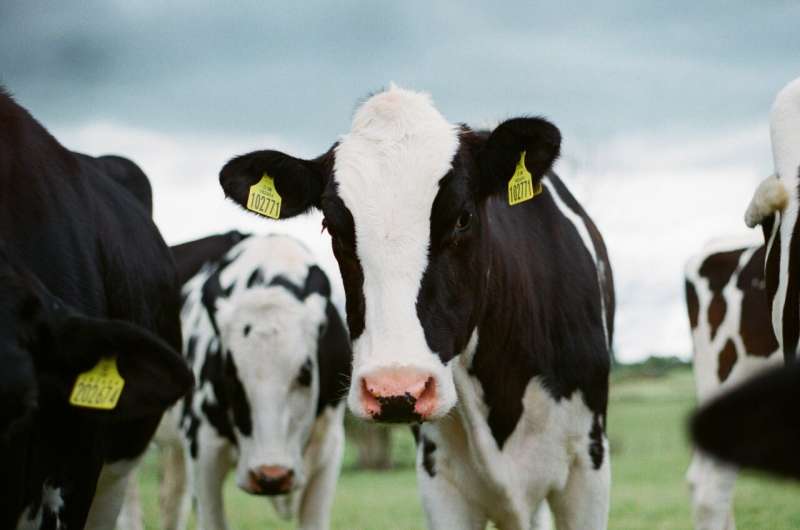
Scientists at the United States Department of Agriculture’s National Animal Disease Center, with multiple academic, state and federal collaborators, identified the emergence and interstate spread of highly pathogenic avian influenza A (H5N1) in dairy cattle.
Genetic analysis confirms that a reassortment event in wild birds preceded a single transmission to cattle, after which asymptomatic or presymptomatic cattle facilitated the virus’s spread across the United States. Viral genome sequencing revealed low-frequency mutations linked to transmission efficiency and mammalian adaptation, raising public health concerns about future zoonotic spillover.
Highly pathogenic avian influenza viruses cause critical damage to animal health and the agricultural economy and may carry pandemic risk. Viruses related to the goose/Guangdong 2.3.4.4 hemagglutinin H5NX clade have spread to nearly 100 countries, creating a recognized panzootic.
After a trans-Atlantic introduction in late 2021, clade 2.3.4.4b H5N1 caused widespread outbreaks across North America, leading to extensive mortality among wild birds, poultry, and mammals. Cross-species transmission events raised urgent concerns about the virus’s adaptation potential. Ongoing circulation of HPAI clade 2.3.4.4b in mammals requires careful monitoring to understand risks for human infection and transmission.
In the study, “Emergence and interstate spread of highly pathogenic avian influenza A(H5N1) in dairy cattle in the United States,” published in Science, researchers conducted a genomic and epidemiological investigation to determine the source, spread, and implications of the outbreak among cattle.
Samples were obtained from 26 dairy farms across eight states and six poultry farms across three states during the initial outbreak.
Researchers performed whole-genome sequencing on viral samples collected from cattle and poultry. Phylodynamic analysis and Bayesian phylogenetic modeling traced the source and spread of infection.
Epidemiological investigations documented animal movement patterns associated with virus dissemination. Within-host evolutionary assessments characterized genomic diversity among cattle isolates. Transmission chains were reconstructed using custom genomic analysis software.
H5N1 clade 2.3.4.4b genotype B3.13 influenza A virus was confirmed in milk samples with limited detection in nasal swabs.
Phylogenetic analysis showed that virus sequences isolated from cattle clustered within a single group, supporting a single wild bird-to-cattle spillover event in late 2023, with several months of silent cattle transmission before a March 2024 confirmation. A reassortment event in wild birds preceded the spillover.
After introduction into cattle, the virus persisted with evidence of transmission from cattle into poultry, raccoons, cats, and wild birds, including common grackles, blackbirds, and pigeons.
One dairy worker was infected with a genotype slightly distinct from sampled cattle but epidemiologically linked. While the infection most likely originated from cattle based on exposure history, transmission from another unsampled host cannot be fully excluded.
Epidemiological records and phylodynamic modeling documented that movement of asymptomatic or presymptomatic Texas dairy cattle resulted in dissemination of the virus across eight states. Field data suggest cows may shed virus for two or three weeks.
Whole-genome sequence analysis identified low-frequency genetic variants associated with virulence, mammalian adaptation, and expanded host range, indicating that the virus circulating in dairy cattle may possess latent evolutionary potential to become more transmissible or pathogenic in mammals. While these variants are not dominant, monitoring is critical, as their expansion could increase zoonotic risk.
Continued transmission of H5N1 HPAI within dairy cattle populations increases the risk for infection and spread of the virus to humans and other animal hosts. Molecular markers associated with increased transmission efficiency and phenotypic changes were detected at low frequencies in cattle isolates.
Viruses circulating in cattle represent a potential pandemic threat, given the evidence of cattle-to-human transmission events. Monitoring of cattle and other agricultural animals is essential for early warning and risk assessment. The findings stress the need for testing cattle before interstate movement and a National Milk Testing Strategy.
More information:
Thao-Quyen Nguyen et al, Emergence and interstate spread of highly pathogenic avian influenza A(H5N1) in dairy cattle in the United States, Science (2025). DOI: 10.1126/science.adq0900
© 2025 Science X Network
Citation:
Hidden transmission of avian influenza virus H5N1 found in Texas dairy cattle (2025, April 29)
retrieved 1 May 2025
from https://medicalxpress.com/news/2025-04-hidden-transmission-avian-influenza-virus.html
This document is subject to copyright. Apart from any fair dealing for the purpose of private study or research, no
part may be reproduced without the written permission. The content is provided for information purposes only.


